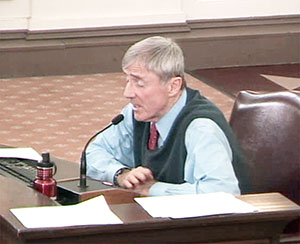
Alderman-At-Large Jack Connolly is advocating a new approach to dealing with opiate addiction problems in Somerville, based on policies and programs already tried out in the city of Gloucester.
By Josie Grove
“You can’t arrest your way out of the addiction problem,” says Alderman-At-Large Jack Connolly of Somerville’s increasing incidence of addiction to opioid pain relievers. “That’s just not something that’s possible. You can’t just round up people who have overdosed and put them in jail, and have them go through a very difficult withdrawal process. They’ll be right back on the street.”
Fatal drug overdoses are on the rise in Somerville; there were four in 2012, eight in 2013, and 12 in 2014. Arresting is also ineffective because legal drug users are also at risk. According to Department of Public Health data for Middlesex county, over 12 in every thousand prescribed opioid users exhibit “activity of concern” for abuse.
The city has chosen to take a public health approach to the problem, rather than a criminal one. “The big issue is we’re not looking to arrest addicts as much as we’re trying to help people,” said Connolly. By arresting users, he says, “You’re not doing anything to help them. But if you try and you work with someone to get educated about the problem, and get some of the support services available, you’ll be in a much better place.”
On Monday, the Committee of Public Health and Public Safety discussed Somerville’s response to the rising rate of opioid abuse and overdoses. “The committee oversees what happens with those types of issues from a public health point of view,” explained Connolly, who chairs the committee. He believes the city involvement is justifiable because the causes of addiction and abuse are bigger than individual users, and the effects reach across the community. “It’s a health issue, it’s one that the industry has perpetuated. Some doctors were prescribing those things like candy, and some of those doctors might have been in Somerville institutions,” he says. “If they are being abused, it’s up to us to alleviate those problems. Just like if there was an outbreak of lice or some sort of health issue, we’d have to do our best to educate people.”
Connolly thinks that the city’s response – coordinated with police and fire departments, schools, nonprofit organizations, and health care providers – has been effective, but he wants to do more. “We’re going to maintain a vigil to make sure that things don’t get sidetracked, to make sure that things keep moving forward. That’s our role as the Public Health and Safety Committee, to make sure that the community is dealing with this issue.”
The opioid issue is hardly unique to Somerville. Statewide, the rate of overdose deaths has spiked since 2012, and every city is trying to find a way to cope. Connolly is looking carefully at the response in Gloucester, a program called Police Assisted Addiction and Recovery Initiative. According to Connolly, “People who have addiction problems, if they report themselves to the police and turn over all their stuff, the police will try to find them a better place to overcome the addiction.” Rather than charging these people with crimes, the Gloucester police connect the individual with an “angel,” who meets them at a hospital to begin treatment. The program is the only one of its kind in the country. “It’s certainly an improvement,” says Connolly. The program began in June of this year, and the town is already seeing results. “Gloucester has reported sixteen or seventeen individuals who are improving and doing better,” Connolly said.
Another benefit of this approach? “It’s more cost effective than putting someone in jail,” says the alderman. Gloucester reports having spent only around $1000 on the program since June. “It’s going to save us money in the long run by taking this type of approach,” which emphasizes education and connecting addicts to services.
“We want to minimize and cut back the number of people who have problems with addiction,” Connolly affirms. “And this one meeting isn’t going to resolve that but it’s a long journey to begin to reduce and hopefully at some point eliminate the problem we have.”













Reader Comments